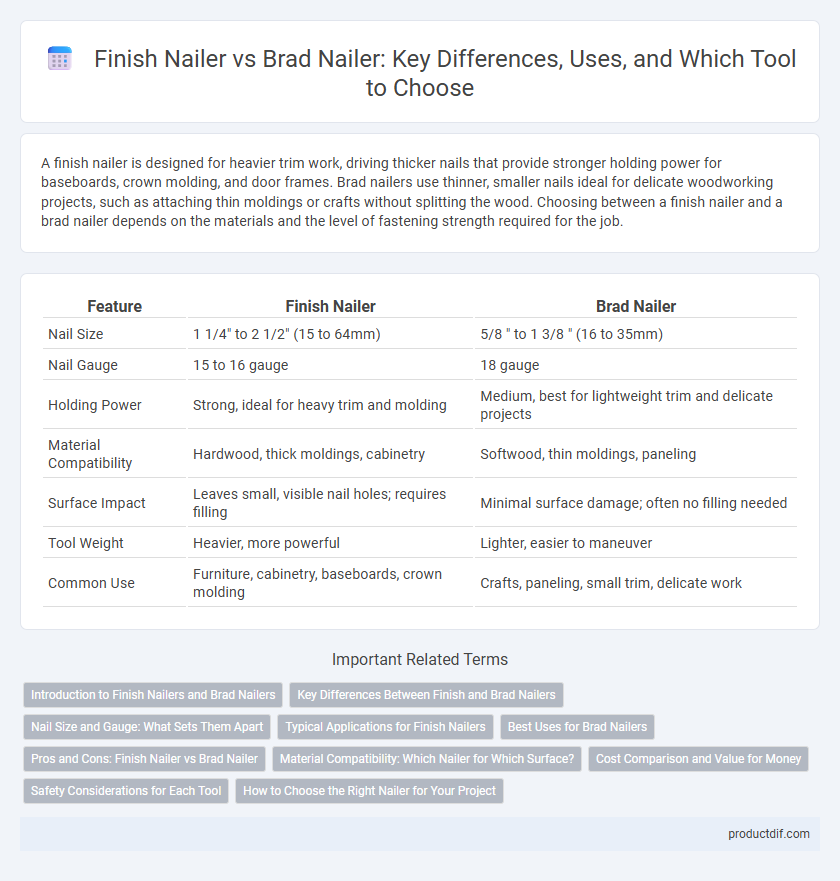A finish nailer is designed for heavier trim work, driving thicker nails that provide stronger holding power for baseboards, crown molding, and door frames. Brad nailers use thinner, smaller nails ideal for delicate woodworking projects, such as attaching thin moldings or crafts without splitting the wood. Choosing between a finish nailer and a brad nailer depends on the materials and the level of fastening strength required for the job.
Table of Comparison
| Feature | Finish Nailer | Brad Nailer |
|---|---|---|
| Nail Size | 1 1/4" to 2 1/2" (15 to 64mm) | 5/8 " to 1 3/8 " (16 to 35mm) |
| Nail Gauge | 15 to 16 gauge | 18 gauge |
| Holding Power | Strong, ideal for heavy trim and molding | Medium, best for lightweight trim and delicate projects |
| Material Compatibility | Hardwood, thick moldings, cabinetry | Softwood, thin moldings, paneling |
| Surface Impact | Leaves small, visible nail holes; requires filling | Minimal surface damage; often no filling needed |
| Tool Weight | Heavier, more powerful | Lighter, easier to maneuver |
| Common Use | Furniture, cabinetry, baseboards, crown molding | Crafts, paneling, small trim, delicate work |
Introduction to Finish Nailers and Brad Nailers
Finish nailers drive 15- to 16-gauge nails designed for trim and molding projects, offering strong holding power with minimal surface damage. Brad nailers use thinner 18-gauge nails ideal for delicate woodworking, preventing wood splitting and providing a nearly invisible finish. Both tools optimize fastening precision in cabinetry, furniture assembly, and detailed woodwork applications.
Key Differences Between Finish and Brad Nailers
Finish nailers use 15-gauge nails, providing greater holding power for heavy trim and molding, while brad nailers use thinner 18-gauge nails ideal for delicate or smaller projects. Finish nailers accommodate longer nails, typically 1.25 to 2.5 inches, suitable for securing larger wood pieces, whereas brad nailers shoot shorter nails ranging from 5/8 to 1.5 inches for lighter attachment needs. The difference in nail size impacts the level of surface damage, with brad nailers leaving smaller holes that require less filling compared to finish nailers.
Nail Size and Gauge: What Sets Them Apart
Finish nailers typically use 15- or 16-gauge nails ranging from 1 to 2.5 inches, providing strong holding power for heavier trim and molding. Brad nailers use thinner 18-gauge nails, usually 5/8 to 2 inches long, ideal for delicate trim work and preventing wood splitting. The difference in nail size and gauge directly impacts the finish quality and suitability for various woodworking projects.
Typical Applications for Finish Nailers
Finish nailers are commonly used for installing trim, baseboards, crown molding, and door casings where a more robust and concealed fastener is required. These tools effectively drive larger nails that provide greater holding strength for heavier woodwork compared to brad nailers. Their precision and power make them ideal for cabinetry, furniture assembly, and other finish carpentry tasks demanding durable, clean fastening.
Best Uses for Brad Nailers
Brad nailers excel in delicate woodworking tasks, such as trim work, cabinetry, and molding installation, where a smaller nail head minimizes surface damage. Their lightweight design and precision make them ideal for attaching thin or fragile materials without splitting the wood. Brad nailers are best used for professional finish work requiring a clean, smooth finish with less repair and touch-up.
Pros and Cons: Finish Nailer vs Brad Nailer
Finish nailers provide stronger holding power with larger 15-gauge nails, making them ideal for heavy trim and cabinetry, though they can leave more visible holes requiring filler. Brad nailers use thinner 18-gauge nails, minimizing wood splitting and reducing surface damage, making them perfect for delicate molding and lightweight projects but offering less structural strength. Choosing between a finish nailer and brad nailer depends on project demands for durability versus subtlety in nail visibility.
Material Compatibility: Which Nailer for Which Surface?
A finish nailer is ideal for hardwoods, trim, and molding due to its larger nails that provide strong holding power without splitting dense materials. A brad nailer suits delicate surfaces like thin plywood, paneling, and lightweight trim where smaller, less intrusive nails minimize surface damage. Selecting the appropriate nailer depends on the material's density and the need for discreet fastening to ensure a professional finish.
Cost Comparison and Value for Money
A finish nailer typically costs between $100 and $200, while a brad nailer is priced lower, ranging from $50 to $150, making the brad nailer more budget-friendly for lightweight projects. In terms of value for money, the finish nailer offers greater versatility and stronger hold for trim and molding, justifying its higher price for professionals and serious DIYers. Brad nailers provide excellent value for delicate, detail-oriented tasks where minimal wood splitting is essential, ideal for cost-conscious users needing precision without heavy-duty power.
Safety Considerations for Each Tool
Finish nailers require careful handling due to their higher power and the risk of deeper nail penetration, making protective eyewear and secure grip essential to prevent accidents. Brad nailers pose a lower risk of injury because of their smaller nails and lighter impact, but safety gloves and eye protection remain important to avoid minor punctures and debris. Both tools must be used according to manufacturer guidelines, ensuring the workspace is clear and the tools are properly maintained to minimize hazards.
How to Choose the Right Nailer for Your Project
Choosing the right nailer depends on the specific requirements of your project, such as the size and fragility of the materials. Finish nailers use larger, 15- to 16-gauge nails ideal for trim work and heavier moldings, providing strong holding power without splitting wood. Brad nailers utilize thinner, 18-gauge nails suitable for delicate tasks like cabinetry and small crafts, where minimizing wood damage and visibility of nail holes is crucial.
Finish Nailer vs Brad Nailer Infographic

 productdif.com
productdif.com